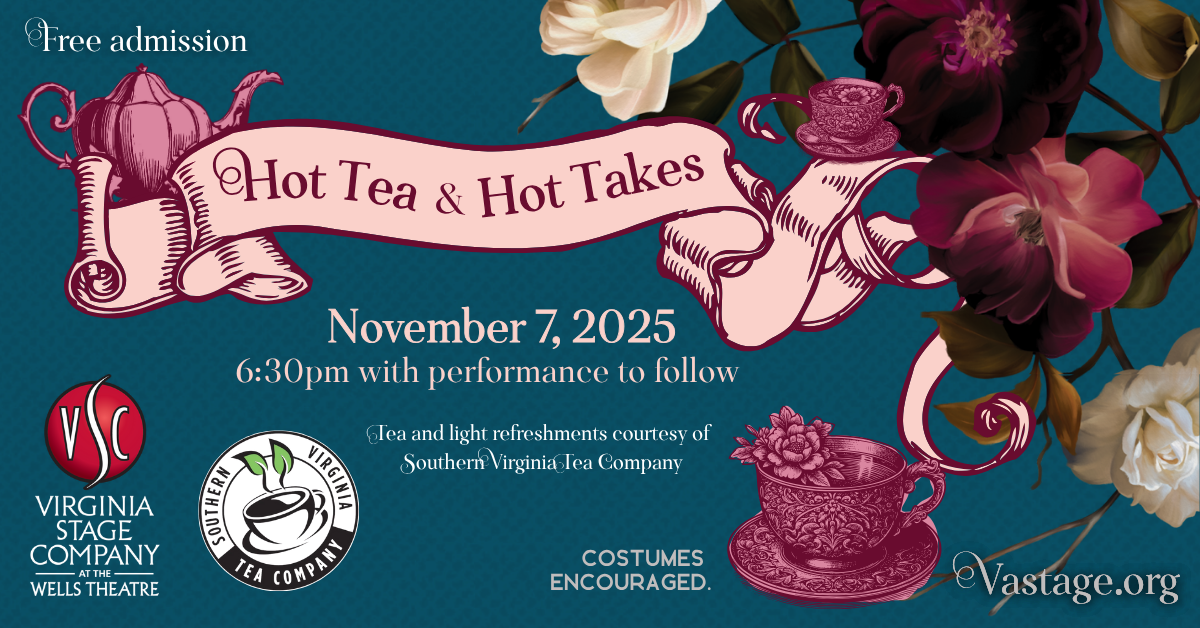Our leading ladies brought their charm, wit, and just the right amount of mischief to The Hampton Roads Show! Watch now…
EMMA | Social Status and Making Your Mark
This study guide was created through a partnership between Roadsted Montessori Middle and High School and Virginia Stage Company. The students read the novel Emma and conducted research on Jane Austen as well as the Regency time period. With guidance from Virginia Stage Company, they wrote articles on a variety of topics centered around the novel and the time period to provide context for Virginia Stage Company's production of Emma.
Etiquette and Manners
Mason Savage, 10th grade
Speech alone is a very precarious subject. There are topics that are essentially banned from public conversation. Generally accepted “good social skills” are a handful of honorable traits: you have to be comfortable in whatever situation that arises, even if it means blatant dishonesty or withholding truth.
In public, more rules need to be followed. Unmarried men and women cannot be alone together without a chaperone, acting as both referee and witness to their interaction. If an unmarried woman flirts excessively or engages in private conversation with a man, it is seen as a sign of attachment, or strong desire to be engaged. In conversations, use of first names is reserved for family members or close same-sex friends of the same social status. In all other cases honorifics – Mr, Mrs, Miss, Lord – are the proper way to address a person. Failing to observe this etiquette is not only considered disrespectful but also crude, a lack of refinement associated with lower class. When Mrs. Elton, blurts out “Knightley,” rather than “Mr. Knightley,” she embarrasses everyone in the conversation.
Fun events, like balls, are as bound by the rules of etiquette as daily interactions. At a ball, two people can not be engaged in conversation if they have not been formally introduced to one another. And a man is not allowed to have more than two dances with the same woman, unless they are engaged. So when Frank Churchill secures Emma for the first two dances at the Crown Inn ball, he sends a clear marriage signal her way. This, by the way, was a ruse designed to cover up his secret engagement to Jane Fairfax, a woman whose class is decidedly below his. Why this deception? Mr. Churchill is in danger of provoking his aunt’s wrath and thus losing his inheritance.
Wealth and Finance
Lenorah Hunt, grade 11
Here in England, women and men having money to inherit is very important! Especially these days… If you have nothing to inherit, or maybe not much, it’s very likely you’ll have to marry! And marrying is key to social mobility, either remaining in your class or going up in class. Look at Mr. Frank Churchill! He is in love with the poor, orphaned Jane Fairfax and wants to marry her. But, oh no, his aunt won’t allow it! She wants him to marry the daughter of a gentleman. If he opposes her will, she will disinherit him!
Well, if you’re born into money, you don’t have to worry about marriage that much. Take Ms. Emma Woodhouse, for example! She will inherit her father’s estate. As she tells her less lucky friend, Harriet Smith, “I have none of the usual inducements of women to marry….. a single woman, of good fortune, is always respectable.” That is, she won’t fall to the condition of Miss Bates, an old, single woman, who counts her pennies and relies on the benevolence of wealthy women like Emma herself. Not having to worry about marrying, Emma is free to do what gives her great pleasure: play a matchmaker to her naive sidekick, Harriet Smith, the poor boarder at Mrs. Goddard’s school.
Ballroom Dancing in Emma
Devin Stiffler, 10th grade and Cyprus Garrenton-Wagner, 11th grade
Mr. Elton, the vicar of Highbury, refused to dance with Harriet Smith at the Crown Inn ball. Harriet, a young and sweet girl with unknown parents, had no dancing partner. Mr Elton was asked by an acquaintance to dance with her, but he declined, citing his recent engagement. The truth of the matter was that he didn’t want to dance with Harriet because she was lower in class than him. And what would people think of him? Stooping down to dance with a poor border from Mrs. Goddard’s school! Is he that desperate? Dancing only with those whose social status you share demonstrates and affirms your position in society. Only men have the power to ask women to dance, but women have the power to decline.
The ability to dance is a great trait for men and women alike to have. It is a way to pass the time and meet people, regardless of class. Dances can be held at the large houses of the gentry. But they can also be held at places like the village inn. For men, asking a woman to dance is a way to express romantic feelings. It is safe to stay with the same person for two dances, but if you stay with the same partner for more than that, it serves as an announcement for serious intentions, i.e. marriage.
Publishing History
Lenorah Hunt, 11th grade
Publishing a book here in England has always been difficult for women to do. And Jane Austen herself isn’t wealthy, so the expenses were quite difficult for her! She took it upon herself to find a publisher for Emma and do the financial arrangements herself. She had to do it alone, because her brother was ill and could not negotiate for her as he usually did. Ms. Austen chose the prestigious publisher John Murray.
Things did not go smoothly, however. To publish Emma, Mr. Murray offered Ms. Austen 450 pounds for the copyright of Emma and two of her previously published novels (Mansfield Park and Sense and Sensibility). She was not happy! One could publish a novel by selling the copyright or on commission. Ms. Austen had made good money from publishing on commission so she refused to sell her copyrights.
In late autumn of 1815 Mr. Murray agreed to publish Emma on commission, deciding on a larger edition, even though paper was very expensive, and 2,000 copies. A copy costs one guinea, which is about $100! But unfortunately for Ms. Austen, only about two-thirds of this edition sold. The price of the remaining copies was significantly reduced.
The following year, 1816, Emma made it to America, where it was printed by the Philadelphia publisher Mathew Carey. Ms. Austen’s novels were published in other countries as well, sometimes with her knowledge, other times, without it. But she made no profit from all of this because there was no international copyright law!
EMMA | Dressing the Part: A Guide to Regency Fashion
This study guide was created through a partnership between Roadsted Montessori Middle and High School and Virginia Stage Company. The students read the novel Emma and conducted research on Jane Austen as well as the Regency time period. With guidance from Virginia Stage Company, they wrote articles on a variety of topics centered around the novel and the time period to provide context for Virginia Stage Company's production of Emma.
Charly Dalrymple, 12th grade
The Muslin Dress
Gone are the days of loud displays of wealth in the dresses of the aristocrats; a new, modern look is taking society by storm. Sleek, refined elegance, reminiscent of the pure white Roman statues recently uncovered in Pompeii and Herculaneum, creates the look of the turn of the century. Popularized in the early 1780s by Queen Marie Antoniette, the flowing muslin dress, which resembles a garment one might wear to sleep, has high society wide awake. The dress was brought to the wardrobes of British women after actress Mary Robinson wore it in 1782. This dress perfectly embodies the desired aesthetics of the modern era. Following the revolution in France, the extravagance of the aristocrats became an embarrassment. A more refined and reserved style is the best way to subtly show your wealth. The white fabric adds a degree of class to anybody who wears it. Any lady today who considers herself fashionable must certainly invest in this timeless style.
Boy’s Fashion
Boyhood begins and ends with fashion. When your young lad leaves behind the tiny frocks and gowns of his infancy for the trousers of boyhood, he begins his long path towards manhood. Three to four years of age is a good time for a young boy to receive his first pair of trousers, but by 15, he is developing into a young man and should start to dress himself in more adult styles. Similarly, a girl becomes a woman around the same age and is considered marriageable. Her dress should now reach down to her feet, a symbol of her maturity. Tailcoats and breeches mark the transition from boy to man, and are a must-have in the closet of any respectable gentleman. In some spaces, trousers are actually starting to become popular among adult gentlemen.
Men’s Fashion
With the recent Napoleonic wars, men are taking influence from military uniforms worn in battle and are translating these silhouettes into daily wear. The high collars and flowing tailcoats create a masculine shape, worn both on and off the battlefront. The quality of a garment is defined by the quality of its fabric. You can't go wrong with wool, dyed a deep masculine shade of blue or brown. Like the Roman leaders of times past, a gentleman's hair should be kept short. Frilly lace and decorative elements exist only in the sphere of womenswear, and any man meaning to be taken seriously in his position should refrain.
The Elements of an Outfit
A corset is a much-needed undergarment for any lady. Providing support and shaping the figure, the modern corset serves to soften a woman's shape and highlight her bust, creating an elegant and beautiful figure. A petticoat sits atop the corset, draping over the figure, creating that ideal shape all women today are looking for. Overtop of this petticoat, a dress should be worn. A nice dress made of high quality muslin is sure to signify your good taste.
Hair
Elegance does not stop with your clothes. Hair fashioned in elaborate styles of ringlets and curls, and decorated with gems, hats, and ribbons, calls back to Greek antiquity and timeless style. Heat can be applied to hair in order to achieve those classic curls. Hair should be parted down the middle, with curls embellishing the sides or framing the face. Hair can be pulled back and up into a bun, crowning the head. Pins and clips can help you maintain your style.
Diving Deeper into EMMA | Unveiling the Image of the Author
Emma Synopsis
Meet Emma Woodhouse: young, clever, rich... and just a little too sure she knows what’s best for everyone else. With her governess happily married (thanks, she’s certain, to her own matchmaking skills), Emma decides her next project will be finding love for her new friend, Harriet Smith. What could possibly go wrong?
Plenty, as it turns out. Despite warnings from her friend and neighbor, Mr. Knightley, Emma dives headfirst into everyone’s romantic business. Soon, her plans for Harriet and the local rector, Mr. Elton, take a disastrous turn. And just when things couldn’t get more complicated, two intriguing newcomers arrive in Highbury: the effortlessly perfect Jane Fairfax and the charming, flirtatious Frank Churchill.
Between misunderstandings, secret crushes, and more than a few bruised egos, Emma starts to realize that love... real love... can’t be plotted out like a game of chess. Sometimes it takes a few mistakes (and one very patient friend) to see what’s been in front of you all along.
In this fresh, funny adaptation by Kate Hamill, Jane Austen’s timeless story gets a clever, contemporary twist. Expect quick wit, bold characters, a dash of chaos, and plenty of heart. Emma may wear a Regency gown, but she has a thoroughly modern spirit. And a knack for learning her lessons the hard way.
So sit back and enjoy the matchmaking mischief, the tangled love stories, and the sparkling humor that make Emma one of literature’s most irresistible heroines.






